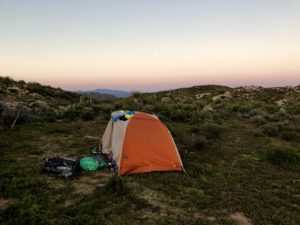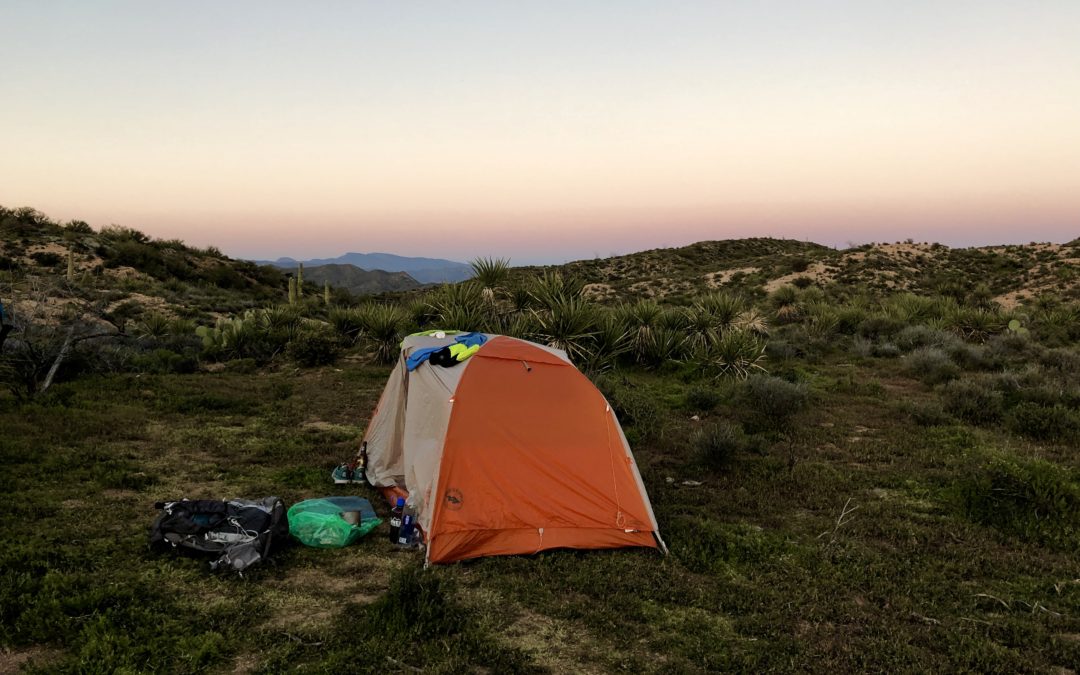
One of the first things I discovered when I started backpacking was that it’s not easy to set up a tent in the wind. Or take one down, for that matter. In fact, strong winds are one of the most destructive elements Mother Nature can throw at your tent.
Because of this, the first thing you should do is check the weather forecast before you head out. I’ve been guilty of checking the forecast for the predicted temperature and whether the day will be sunny or rainy, while neglecting to pay any attention to wind speed.
If you know high winds are predicted, you have a few options. Basically, you can cancel your plans, change your camping location to a place that’s more sheltered, or set up camp earlier or later in the day, when it’s not yet windy or the winds have died down.
But maybe despite all of the precautions, you’re faced with setting up your tent in the wind solo. Here’s what I’ve learned so far.
What NOT to Do When Setting Up Your Tent in the Wind
First, don’t take all of your tent pieces out all at once. If you do, the tent bits may blow all over.
And don’t assume that your oh-so-heavy backpack will easily pin your tent floor to the ground while you set it up. It won’t. If it’s windy enough, your tent will simply tumble around with your backpack inside.
So now let’s learn how to do this right.
Initial Steps to Setting Up Your Tent in the Wind
First, find the most sheltered spot that you can. Trees or thick bushes can do wonders to cut down the force of the wind. However, if you’re considering a spot near trees, make sure the one(s) you’re under don’t have dead, cracked or compromised limbs that could break off and onto your tent.
Second, get organized. If there are rocks nearby, gather them to help weigh down the tent. You’ll likely need rocks about the size of a small loaf of bread. If the wind is really strong, softball-sized rocks won’t be heavy or large enough. Find your tent stakes and put them in one pocket.
Next, determine which way the wind is blowing. You’ll want to site the narrowest part of your tent so it’s facing into the wind. (This narrowest part is typically the foot.) Never set up your tent sideways to the wind, because that gives the wind a lot more surface area to batter.
Now, take out your tent poles and put them together.
Then take out your tent, but not the pad/footprint or fly. (Weigh those down with your backpack, if necessary.)
With your back to the wind and two tent stakes in hand, grab the narrow part of your tent and let the wind blow it away from your body. Then lower it to the ground and stake this side in, placing the stakes at 45-degree angles. You may need to use your feet versus your hands, depending on the conditions.
Next Steps
Now, set your tent poles on top of the tent to hold it down, then clip them in on the staked side. Go to the other side of your tent, stake it in and clip in the poles. Secure the top clips as well, then raise the poles to lift up the tent.
Here comes the most critical part. As quickly as you can, put rocks inside the tent in each corner, plus on top of the exterior clips/cords that are attached to the stakes. Toss your backpack inside once the rocks are in place. If you normally use a tent pad or footprint, place it on the tent floor inside, moving one rock at a time to secure.
Repeat the process above with the tent fly, staking out the narrow side first. If your fly has Velcro straps in addition to clips, use them. Make sure everything is very tight, as a tight set-up gives your tent more resistance.
If your tent has extra stakes and guy ropes, use every one. And if your tent has an air vent near the top, open it. This will allow some of the wind to pass through the tent, lessening its impact.
For those who learn better by seeing, here’s a video I found that shows essentially the system I described.
Take Precautions
While I’ve camped in many windy conditions to date, my tent has always held up. However, you need to be prepared to make repairs. If one of your poles breaks, make a splint out of a flat piece of wood and tie them firmly together. Many tents come with repair kits; make sure to pack yours or buy one. Duct tape can work in a pinch for some repairs, as can a gear sewing kit.
While windy conditions can make it difficult to cook dinner or make coffee in the morning, it’s possible to keep your stove lighted in a safe, sheltered spot outside. But whatever you do, do NOT cook inside your tent. The fumes from a lighted stove can be deadly, and the potential for a fire is real.
Many tents have wind ratings, so if yours does, make sure you know what it is. I can’t find one for my beloved Big Agnes Copper Spur HV Ultralight, but the “ultralight” in the name is an indication that this is not a tent for gale-force winds.
Indeed, one night when I was camping in Big Bend National Park, terrific winds sprang up in the middle of the night. And the only thing keeping the tent on the ground was my body. (Since the wind started in the night, I had no rocks holding it down.)
Taking Down Your Tent in the Wind
During that Big Bend overnighter, the winds persisted into the morning. I had no idea how I was going to get out of the tent without it immediately flying away. And honestly, I forget exactly what I did! But it involved opening the vestibule door and unclipping the poles to collapse the tent ASAP. Then make sure to toss on whatever you need to – rocks, etc. – to weigh it down while you take it apart.
If there is a better solution, I’d love to hear it.
Disclosure: This entry contains affiliate links (among regular links) to products I own and like, or which I think you might like. This means that, at no extra cost to you, I will earn a commission if you click through and make a purchase.




